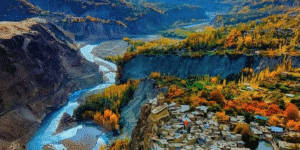The culture of any area represents its behavior, beliefs, traditions, and languages. Culturally, Gilgit Baltistan is a rich area. There are a variety of sects, and besides its small population, almost nine languages are spoken there, which makes Gilgit Baltistan’s culture versatile. Karakorum Mountains give this region a unique history and cultural values. Although it is an Islamic region there is also the influence of other sects and religions on Gilgit Baltistan culture. There is Mangolian, Central Asian, and Tibetan influence on Gilgit Baltistan culture.
For centuries Gilgit Baltistan has remained the home for various civilizations. A caravan of traders, adventurers, and explorers from the whole of the world made it a versatile empire.
Read More: All about Gilgit Baltistan travel Northern Pakistan guide 2024.
Table of Contents
ToggleLanguages
The variety of languages made this region a culturally rich area. The more widely spoken language is Shina language among nine others. Balti and Ladakhi languages are means of communication in major parts of the Gilgit Baltistan region. In Hunza, Nagar and yasin valley Burushaski is more common.
There is rich classical literature is available in Balti language despite of its adverse condition. Literature in other languages is sparse. Various dialect and styles of the Balti language enhances the melody of its poetry.
Despite all other traditional languages English and Urdu are understood by the majority of the population.
Arts and crafts of Gilgit Baltistan
The presence of unique arts and crafts makes the Gilgit Baltistan culture versatile. Arts and crafts of this region especially handmade things are known worldwide. Gilgit Baltistan people have practiced artwork for centuries and some are new skills. Among the embroidered work Dori’s work is more common on Chogas and Gowns. On handlooms, simple design carpet weaving is also a specialty of Gilgit Baltistan.
In the crafts, stonework is renowned for making beautiful stoneware. With the apricot wood traditional spoons are made. Hard walnut wood is utilized to make elegant furniture, boxes, and various other utensils.
Wooden crafts deeply represent the Gilgit Baltistan region. Diamir and Pine wood are also used to make beautiful furniture. Woolen pattu is also a specialty of this region. This region is also famous for embroidered caps.
Food of Gilgit Baltistan
Usually, the people of Gilgit Baltistan use less oil and spices. Traditional foods are more common in rural areas while cities have blends of modern and local cuisine. Balti cooking is more famous in Gilgit Baltistan food culture. Mirpur ancestors, foods of Mughal emperors, and spices of Kashmir altogether make the rich food culture of Gilgit Baltistan.
The most popular traditional dishes are Prapu, Merzan, and Mamtu. Prapu is the handmade wheat noodles boiled in walnut and apricot paste.
Inhabitants of Gilgit Baltistan prefer yak’s milk. It is very healthy and has a high-fat content. There is the dominance of simplicity in their lifestyles. Other famous and traditional dishes of Gilgit Baltistan are Chapshoro, Gyaling, Buroshapik, Diram pitti, Tumoro tea, Hoilo Garma, Buttering Doudo, Harissa, Molida, and Shopan.
Architecture of Gilgit Baltistan
The history of architecture of Gilgit Baltistan is 2000 years old (the era of Aryan King Jamshid). These old traditional houses are perfectly according to the needs and seasons of this area. Modern houses cannot compete with this beautifully design architecture.
Due to the mountainous region, the design of houses is somewhat different from other areas. In the houses, there is one central room. Rooms are raised on platforms with five pillars and a diamond-shaped hole (sagam, som, sum) for smoke, light, and air. The walls are very thick to provide insulation. Houses usually are made up of wood. Upon entering a wide area called Dahlanz leading to the room. The doors are designed small to protect from cold. There are traditional designs and rich carvings on the frames of windows and doors. Some houses also have inscriptions. Altit and Baltit Fort are a rich example of architecture. Floors are covered with carpets.
Now due to the expanding tourism industry there is changing patterns in construction practices. Buildings have more Tibetan and Kashmiri influence.
Dress culture of Gilgit Baltistan
Because inhabitants of Gilgit Baltistan belong to various sects there is a variety of dress designs. Clothing is the identity of a person and must have a traditional effect.
Men of Gilgit Baltistan usually wear Shalwar Kameez and also long coats called anga, trousers, and thick woolen caps. They consider the caps as an honor for them.
Women usually wear long frocks and kurtas. Sometimes their clothes are embroidered. They mostly wore black, blue, and red colors. Woolen shawls are also a part of traditional dresses. Jewelry includes the gold and silver bangles and beaded necklaces.
Event and festivals of Gilgit Baltistan
Gilgit Baltistan traditional festivals and events are not only attractive for locals but also for tourists. In this beautiful valley these festivals are an important part of the Gilgit Baltistan culture. These celebrations enhance social attachments. Over the years the area has witnessed many sorts of territorial, social celeberations.
Some lively and energetic celebrations of Gilgit Baltistan are polo festivals, Gather festivals, Babusar polo festivals, Navroz Festivals, and Ginani Festivals. Polo is one of the famous and favorite games of many districts including Gilgit, Chelas, Astore, Hunza, and Nagar. Polo is the centuries-old game of Gilgit. It is attended not only by locals but every year hundreds of visitors come to Gilgit Baltistan to enjoy this game. Silk route festivals are also another source of opportunity to discover the unique and ancient culture of Gilgit Baltistan.
At the ripe of their yields, they celebrate this with great zeal and zest. Navroz festival is also celebrated with lots of traditional dishes. Nagar and Hunza Valley celeberate the Ginani festival.
Customs and Traditions of Gilgit Baltistan
Gilgit Baltistan’s culture customs and traditions have wider influence on older civilizations due to the Silk Road. This region also has a vibrant tradition of dance and music. Although the inhabitants belong to different ethnic groups but very hospitable and cheerful people. Despite distinct cultural heritages, there is also unity in many aspects of cultural dimensions. They share unity in food, dance, music, and crafts. Gilgit Baltistan has a joint family system. Many generations are living together sharing cordial relations with each other.
To wrap up
With its beauty, culture, and history Gilgit Baltistan is a unique region. It is the word attractive place in all aspects.
FAQ
What is Gilgit Culture?
Language, traditional customs and cultures, food, festivals and events, living styles, arts and crafts, architecture, and history all make the Gilgit culture.
What is famous about Gilgit Baltistan?
Gilgit Baltistan is famous for its outstanding beauty, cultural heritage, world’s highest peaks including K2, and many other famous games like polo.
What is the cultural food of Gilgit Baltistan?
Chapshoro, Gyaling, Ghilmindi, Diram Pitti, Tumoro Tea, Hoilo Garma, Buttering Doudo, Harisa, Molida, and Shopen are the top cultural foods of Gilgit Baltistan.
What is the traditional dress of Gilgit?
Loose, Long baggy trousers with a kameez is the traditional dress of Gilgit.







